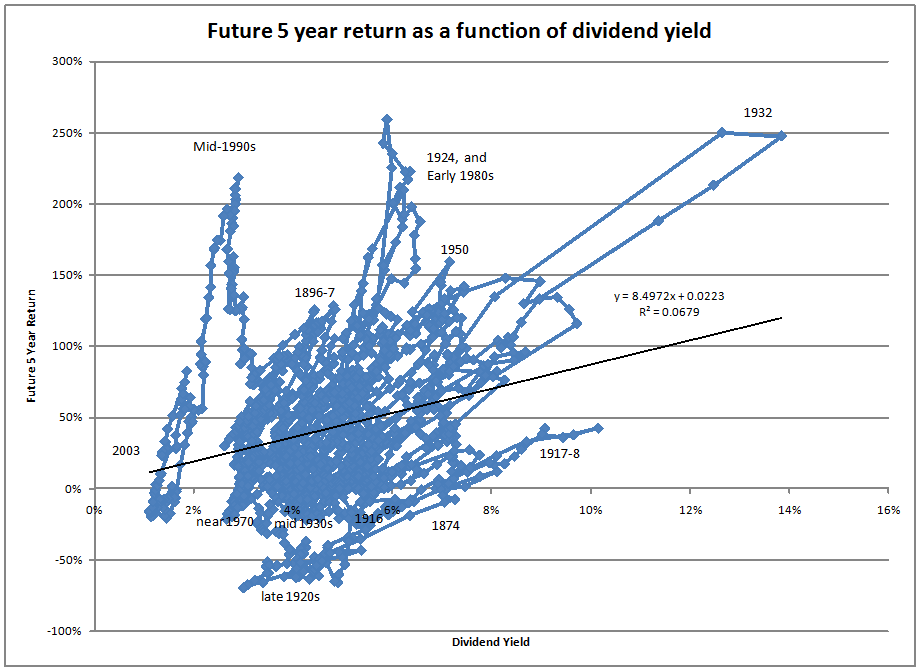Blogging is often a cooperative venture, so this piece begins with thanks to three people:
- James Picerno of The Capital Spectator, who gave me the idea for this piece in his article, WHAT, IF ANYTHING, CAN DIVIDEND YIELD TELL US?
- Eddy Elfenbein, who saw a question that I posted on Bespoke’s website, and sent me a link to
- Dr. Robert Shiller’s website, where I got the data for this post.
When I read the piece at The Capital Spectator, my response was “Huh, neat article, wonder how it would look with a larger data set?”? Given Eddy’s help, I had that data set, and so I got to work.? Here is the main result:
The results at The Capital Spectator went from 1995 to 2003. My results go from 1871 to 2003. His results give a tight relationship, while mine indicate a loose relationship.? His R-squared was far? higher than my 7%.? Why?
In aggregate, many relationships in finance are tenuous.? Do interest rates mean-revert?? Yes, but the tendency is weak.? In this case, high dividend yields foreshadow high five-year total returns, but that tendency is weak.
In the graph above I tried to highlight the eras for different alignments of dividend yields and future five-year returns.? Depending on the era, the relationship of dividend yield to future returns differed.? In the long run, there is a weak positive relationship between dividend yields and total returns, but in the short run, many other factors predominate.
So what does this tell us?
- Use larger data sets when possible.
- Realize that many relationships in finance are not stable.? Indeed, that is a strength of Capitalism.? It adjusts to changing conditions, and is not stable.
- When dividend yields are high the market is attractive.? Of course, factor in how high bond and cash yields are at the time.
- Beware relying on intermediate-term relationships in quantitative finance.? They last for less than a decade.
- Beware trusting correlation coefficients calculated over short intervals.
- In finance, we know less than we think, so we should be cautious in our conclusions.
- The best forecasts come when we are at extreme values of the system.? In the middle, everything is a muddle.
I am a firm believer in dividends. My portfolio has an above average dividend yield.? In general, high dividend yields pay off in investing, subject to credit quality.? But, the payoff varies over time; a heavy reliance on the dividend yield of the market as a sole indicator is not advised.


David:
you’re now a member of what many academics call “the 7% club.” It refers to the fact that many long term studies of effects like this seem to yield R^2 of between 5 and 7% (not all that impressive, when you consider it). It just goes to show how little we really know about the investment process.
Keep up the good work – many of your posts have become required reading for my students.
For crying out loud, when you were on RealMoney, hardly a single Metlife, Allstate or Hartford earnings call could go by without you dropping a note about the latest goings on. HIG is one of the **THE** hottest topics of the week. Ya gotta say **SOMETHING**. It’s your area of expertise! Heck, YOU OWN IT!!! Are you buying more? Are you selling? What went wrong with them? Is the market crazy? Is the battleship sinking?
You should try this again, but instead of looking at dividend yields, look at the spread between dividend yields and corporate bond yields. I wonder if you’d see a stronger correlation then.